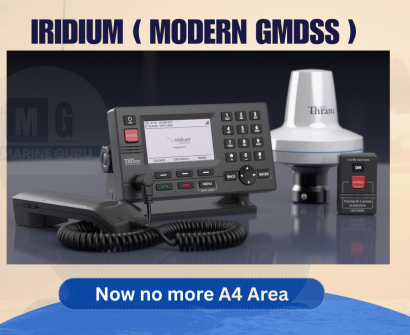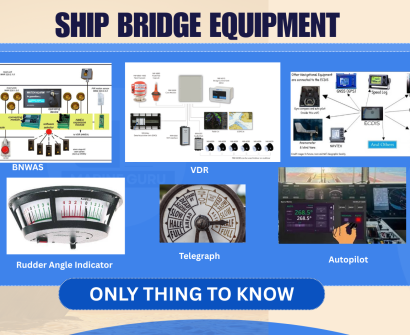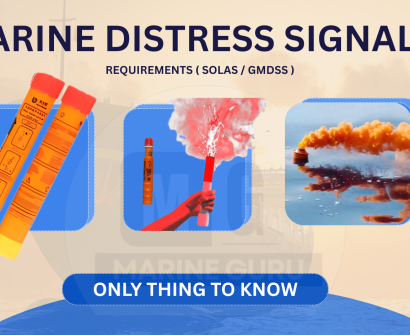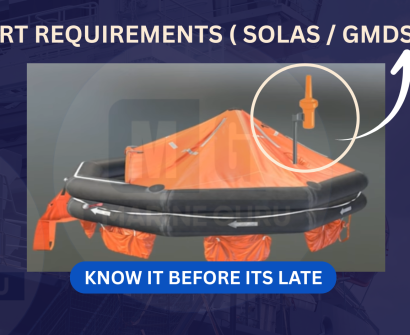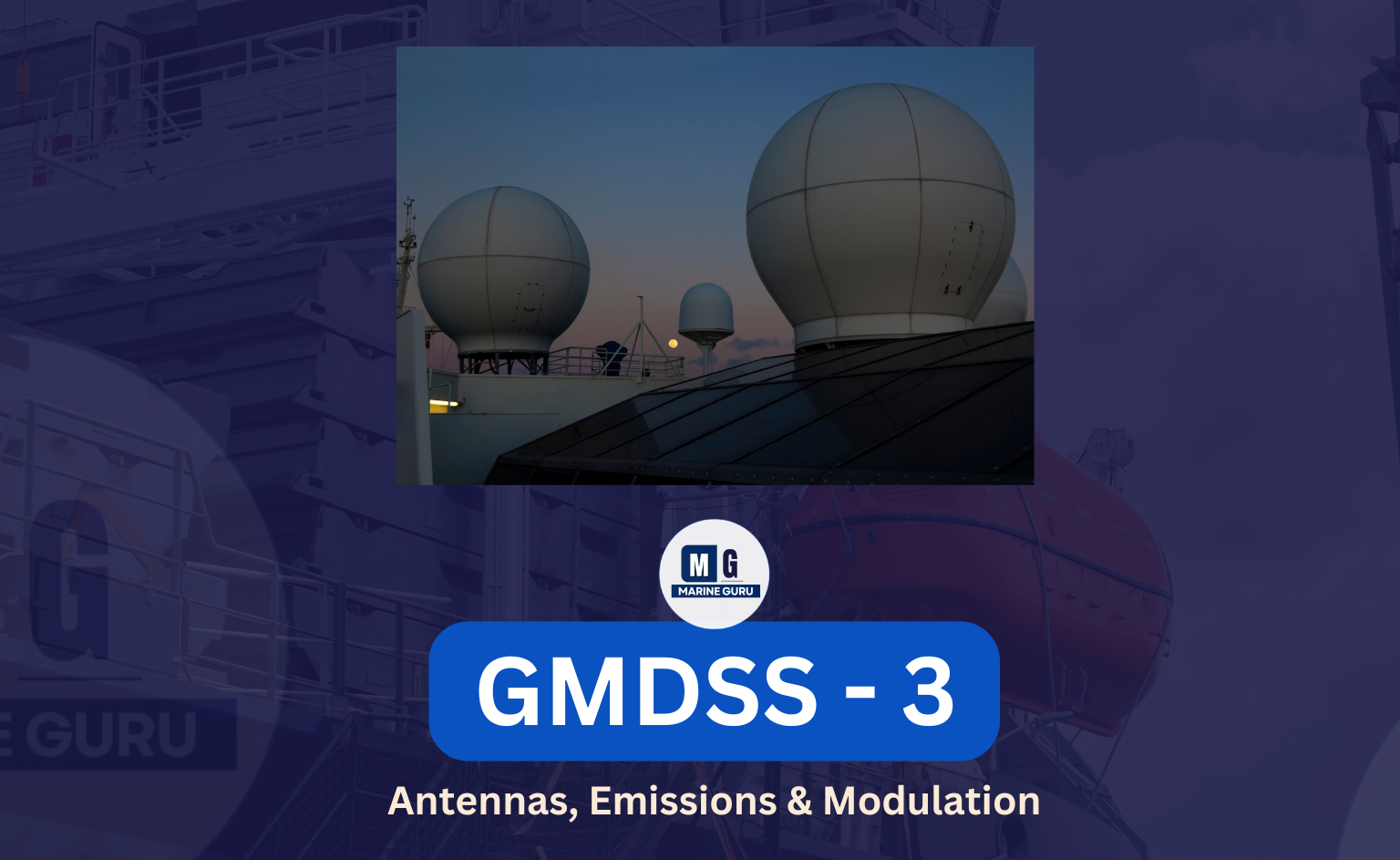
Every GMDSS equipment onboard relies on one unsung hero — the antenna.
Without it, no signal can be transmitted or received.
Whether it’s a DSC distress call, a NAVTEX message, or an Inmarsat email — it all depends on how effectively the antenna handles electromagnetic waves.
In this MarineGuru guide, we’ll decode:
✅ How antennas transmit and receive signals
✅ The types of antennas used on ships
✅ Which antenna connects to which GMDSS equipment
✅ What “emission” really means and why ITU regulates it
✅ Easy memory aids for exams and oral answers
The Purpose of an Antenna
An antenna is the “ear and mouth” of every radio equipment.
Its only job is to transmit or receive electromagnetic energy.
Every GMDSS set — VHF, MF/HF, Inmarsat, NAVTEX, EPIRB — has its own dedicated antenna, usually mounted on the Monkey Island, above the bridge, away from metallic obstruction.
The Transmission System — How Your Radio Sends a Signal
Before understanding types of antennas, it’s important to know what happens inside your equipment when you press “transmit.”
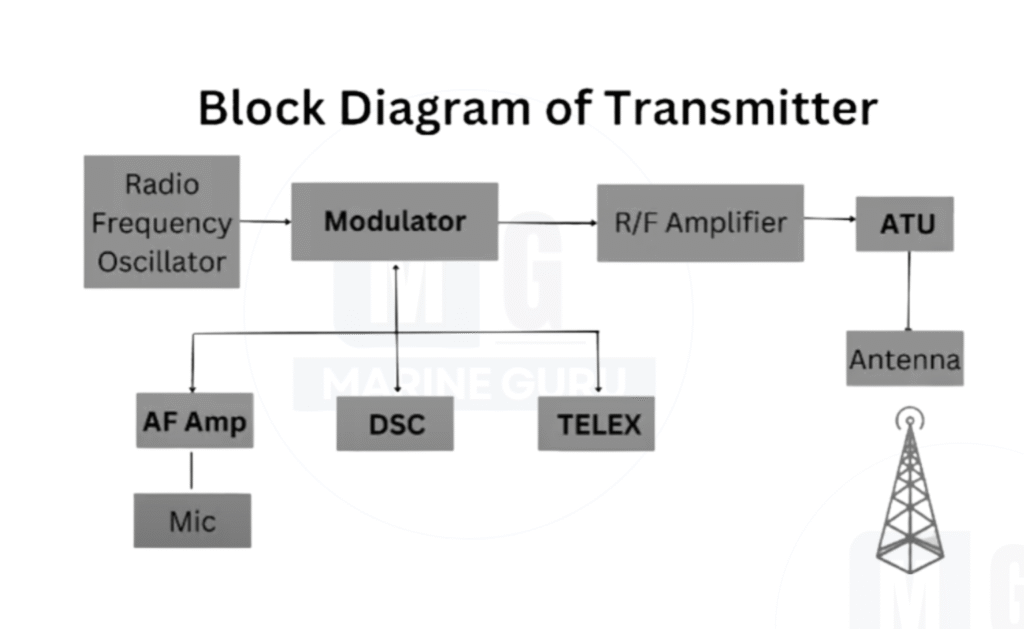
📶 Step-by-Step Signal Flow
- RF Oscillator – Generates the carrier radio frequency.
- Modulator – Superimposes the message (from DSC, Telex, or voice) onto that carrier wave.
- Amplifier – Boosts power for stronger transmission by altering wavelength and frequency.
- ATU (Antenna Tuning Unit) – Adjusts antenna length and impedance to match the frequency.
The Antenna Tuning Unit (ATU) is vital — it allows one shared antenna to handle both MF and HF frequencies by dynamically adjusting its length.
Memory Tip:
“ATU = Antenna Tailor Unit — it tailors height to fit frequency.”
The Reception System — How an Antenna Listens
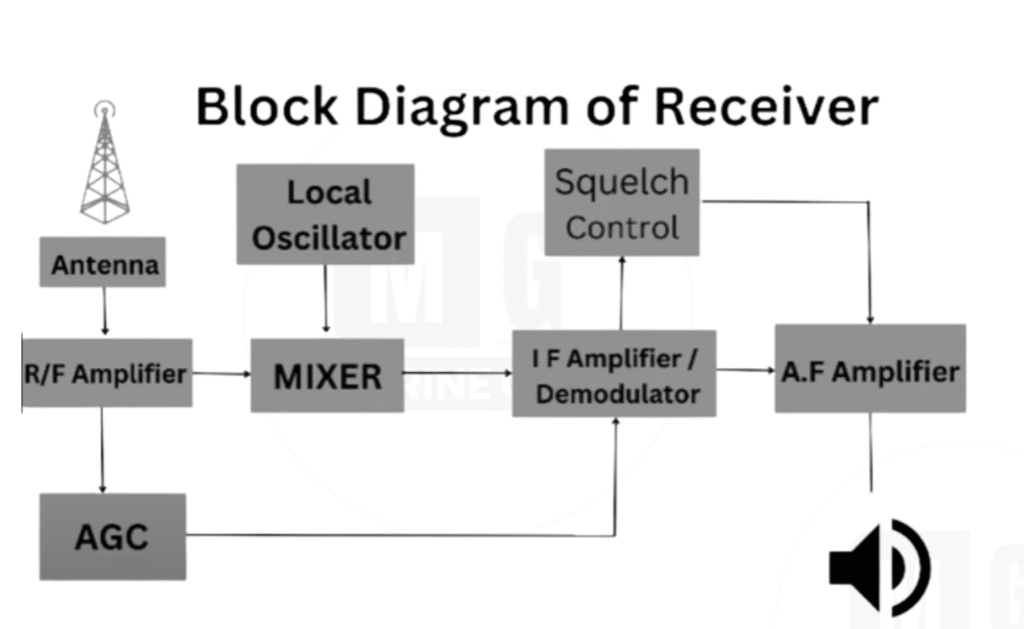
When your ship receives a signal, the process runs in reverse:
- Antenna receives the radio wave.
- RF Amplifier boosts the weak signal.
- Mixer + Local Oscillator combine frequencies for tuning.
- IF Amplifier (Intermediate Frequency) uniformly amplifies the signal for clarity.
- Demodulator extracts the actual information (voice/data).
- AF Amplifier (Audio Frequency) fine-tunes it before sending to the speaker.
- Squelch Control removes static noise when there’s no signal.
Layman Tip:
“Squelch = Silence Button for Noise.”
If you ever wondered why a VHF remains quiet until someone calls — that’s squelch in action.
Factors Affecting Antenna Design
Each ship’s antenna system is designed considering:
- Direction & Power of transmission
- Frequency & Wavelength of signals
- Height above sea level (greater height = greater range)
- Type of communication (satellite, line-of-sight, or long-range)
Types of Antennas Used on Ships
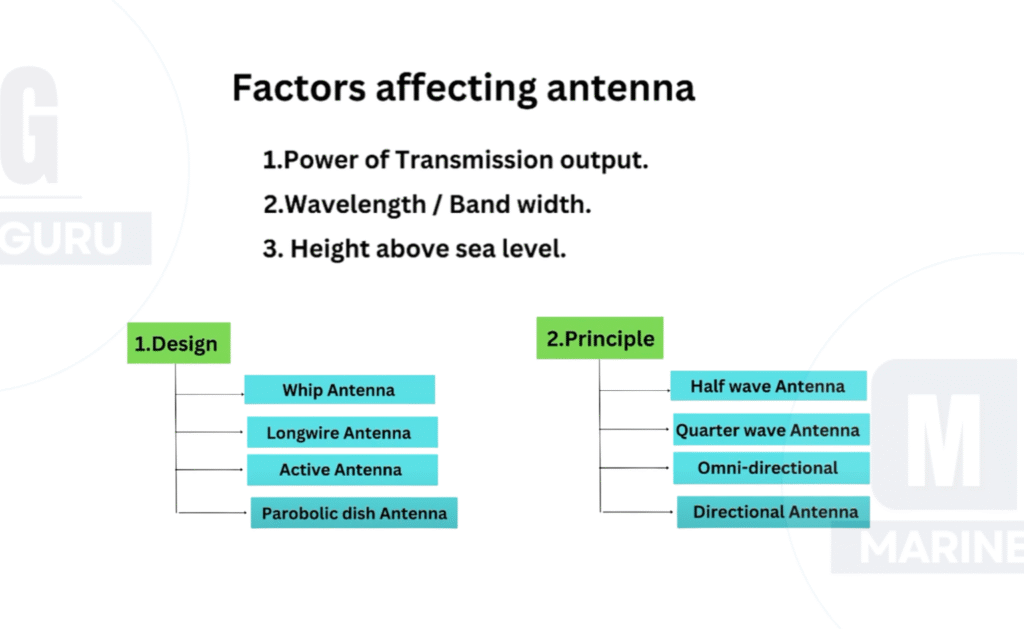
Antennas can be classified by design and principle of operation.
I. Based on Design
| Type | Description | Used For |
|---|---|---|
| Whip Antenna | Long flexible rod type | Common for VHF systems |
| Long Wire Antenna | Horizontal wire stretched between masts | MF/HF long-range sets |
| Active Antenna | Has inbuilt amplifier for weak signals | NAVTEX, GPS |
| Parabolic Dish / Dome (Radome) | Focused beam for satellite comms | Inmarsat-C, Fleet 77 |
Example:
The white dome on the Monkey Island (Fleet 77 / Inmarsat) hides a parabolic dish that constantly tracks satellites — that’s a directional antenna protected inside a Radome made of fiberglass.
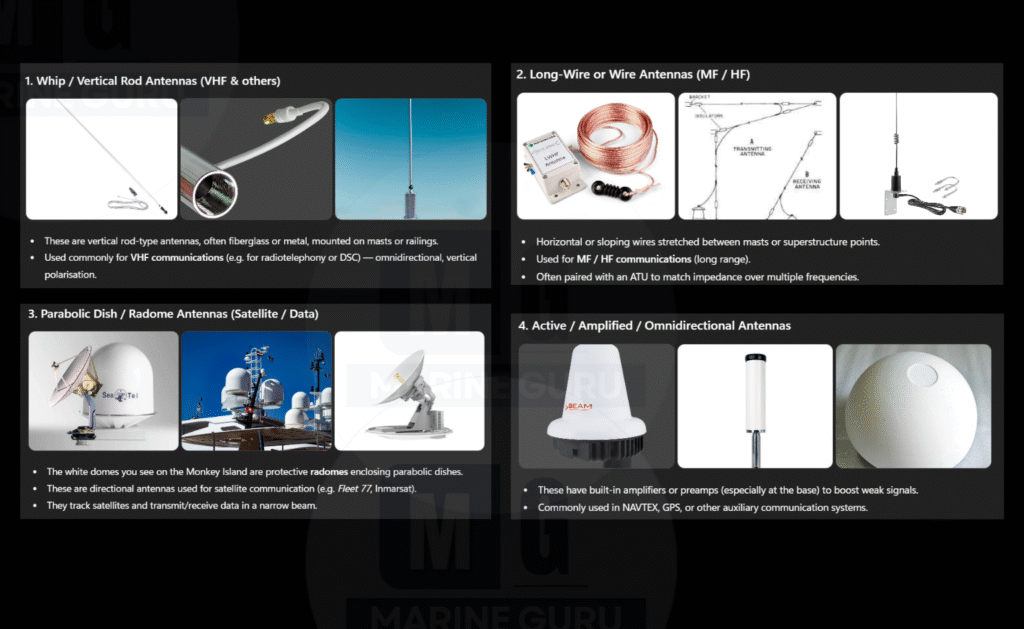
II. Based on Principle
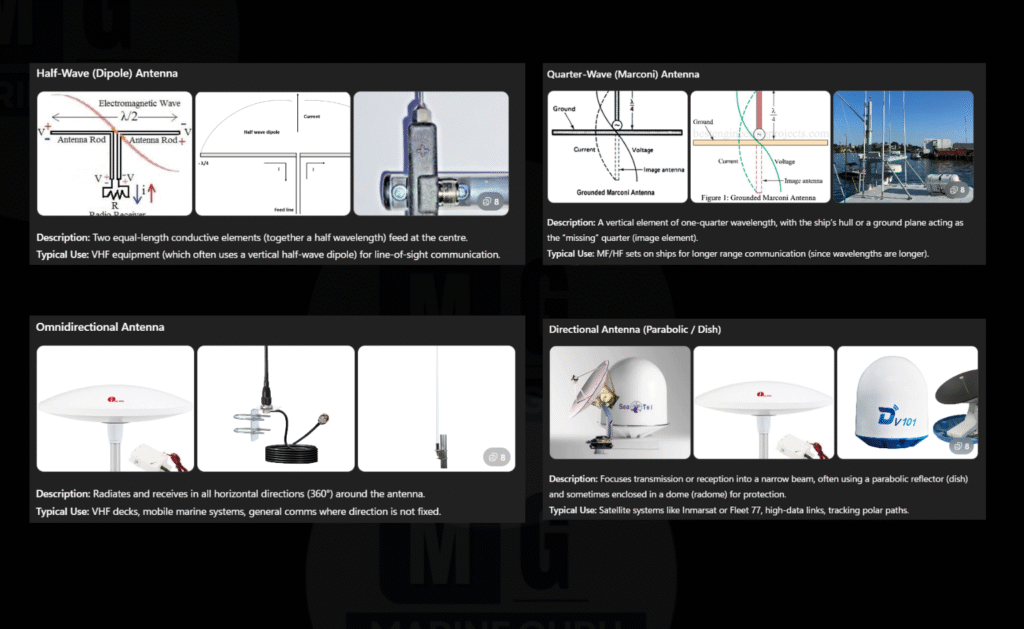
| Type | Description | Used In | Property |
|---|---|---|---|
| Half-Wave (Dipole) Antenna | Omnidirectional, mounted vertically | VHF | Transmits equally in all directions |
| Quarter-Wave (Marconi) Antenna | Named after Guglielmo Marconi | MF/HF | Used for long-range comms |
| Active Antenna | Built-in preamplifier | NAVTEX / GPS | Improves weak signal reception |
| Omnidirectional Antenna | Transmits 360° | VHF, MF, Radar | Used for general communication |
| Directional Antenna | Transmits in narrow beam | Inmarsat Fleet 77 | Used for high-speed data (e.g., chart updates, weather images) |
Memory Trick
| Equipment | Antenna Type | Memory Phrase |
|---|---|---|
| VHF | Half-wave Dipole | “Vertical Voice Hero” |
| MF/HF | Quarter-wave Marconi | “Marconi Made It Long” |
| Inmarsat | Parabolic Dish | “Dish for Data” |
| NAVTEX | Active Antenna | “Active NAV Receiver” |
Emission and Modulation in Radio Equipment
Let’s now demystify one of the most misunderstood terms: emission.
What Are Emissions?
Every radio transmission releases electromagnetic energy — a combination of electric and magnetic waves.
These emissions carry your message across air or space.
However, if not controlled, emissions can become harmful radiation — like X-rays in excess.
Hence, the International Telecommunication Union (ITU) ensures that every communication device, including GMDSS equipment, is type-approved for safe emission limits.
Even your mobile phone and laptop are approved under similar ITU radiation standards.
ITU Classification of Emissions
Each radio transmission is identified by a three-part code — e.g., A3E, J3E, F1B.
| Symbol | Represents | Meaning |
|---|---|---|
| 1st Letter | Type of Modulation | A = Double Side Band, H = Single Side Band (Full Carrier), J = Single Side Band (Suppressed), F = Frequency Modulation, G = Phase Modulation |
| 2nd Character (Number) | Type of Signal | 1 = Digital without sub-carrier, 2 = Digital with sub-carrier, 3 = Analog |
| 3rd Letter | Type of Information | A = Morse (manual), B = DSC/NBDP (auto), E = Voice |
Common Emissions for GMDSS Equipment
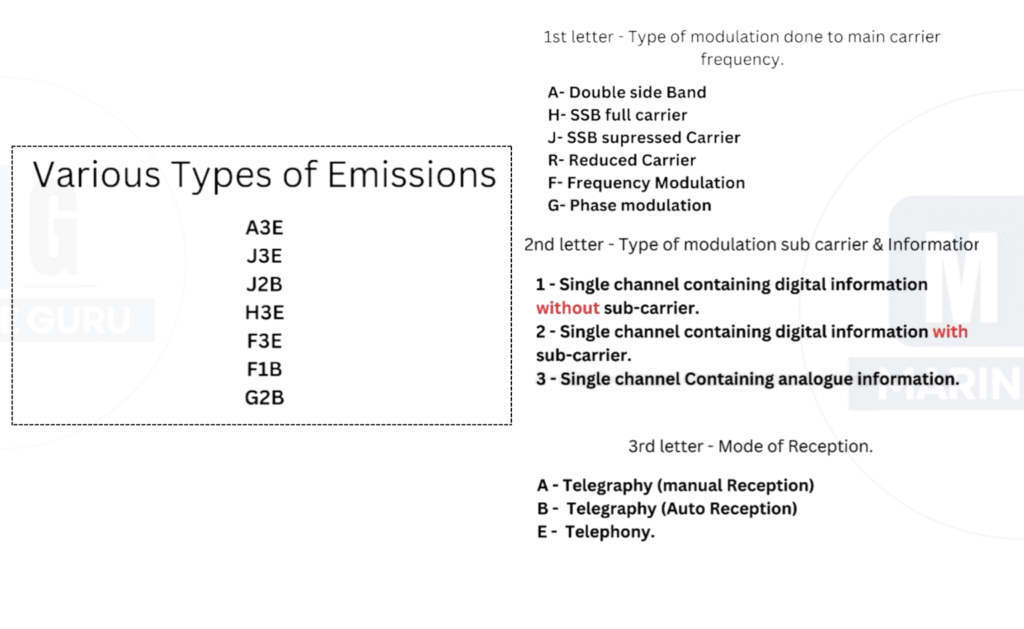
| Emission | Equipment | Mode | Description |
|---|---|---|---|
| A3E | VHF | Radiotelephony | Analog voice transmission |
| J3E | MF/HF | SSB Voice | Reduced carrier for efficiency |
| F1B | MF/HF | NBDP | Frequency-shift keyed telex |
| G2B | MF/HF | DSC | Phase-modulated digital alerting |
| H3E | MF | Voice (with full carrier) | Used on older ships |
| J2B | HF | NBDP | Digital text with sub-carrier |
| A3 | MF | Telegraphy / Morse | Manual communication |
💡 How to Remember
“A H J F G” — Always Handle Just Fine Gear” (Types of Modulation)
“1-2-3” — Digital, Digital + Subcarrier, Analog”
“A-B-E” — Morse, Data, Voice.”
⚠️ Why Emission Standards Matter
In the past, engineers would modify transmitters to send stronger signals — unknowingly producing harmful radiation levels.
ITU standards now prevent such manipulation by fixing emission bandwidths and radiation power.
Hence, every shipboard radio today carries an ITU Type Approval, guaranteeing that:
✅ Emissions are within safety limits.
✅ Efficiency doesn’t cause health hazards.
✅ Compatibility with international frequencies is maintained.
🧠 MarineGuru Summary Sheet
| Topic | Key Points | Example |
|---|---|---|
| Antenna Function | Transmit or Receive EM waves | VHF Antenna transmits DSC on Ch 70 |
| ATU Role | Tunes height for MF/HF | Matches antenna to selected freq |
| Squelch Control | Eliminates static noise | Used in VHF receiver |
| VHF Antenna | Half-wave dipole | Mounted vertically |
| Fleet 77 Antenna | Parabolic dish inside Radome | Satellite communication |
| Emission Example | J3E | SSB Voice on HF |
📚 FAQs — Antennas & Emissions in GMDSS
Q1. What is the main function of an antenna on a ship?
To transmit and receive electromagnetic waves that carry voice, data, or distress information.
Q2. Where are antennas installed on ships?
On the Monkey Island, above the bridge — the highest point to avoid obstructions and maximize range.
Q3. What does the Antenna Tuning Unit (ATU) do?
It adjusts the effective height and impedance of the antenna according to the chosen MF/HF frequency — ensuring optimal power transmission.
Q4. Why are different antennas needed for VHF, MF, and HF?
Because each frequency band has different wavelengths and propagation behavior — requiring unique antenna lengths and designs.
Q5. What is a Radome?
A fiberglass dome protecting the parabolic dish of Inmarsat antennas from weather while allowing radio waves to pass through.
Q6. What is an omnidirectional antenna?
It transmits and receives signals in all directions — commonly used for VHF, MF, and radar.
Q7. What is a directional antenna?
It focuses transmission in a narrow beam, typically for satellite communication systems like Inmarsat Fleet 77.
Q8. What are emissions in radio equipment?
They are the electromagnetic energy radiated by transmitters to send signals.
Q9. Why does ITU regulate emissions?
To prevent equipment from producing harmful radiation and to ensure frequency compatibility across the world.
Q10. What do A3E, J3E, and F1B mean?
They indicate the modulation type, signal type, and information format — e.g.,
- A3E = Voice
- J3E = SSB Voice
- F1B = Telex/NBDP
Q11. Which antenna does VHF use?
A Half-wave Dipole Antenna, mounted vertically — omnidirectional in nature.
Q12. Which antenna does MF/HF use?
A Quarter-wave Marconi Antenna — longer in length for long-range communication.
Q13. Which antenna does Inmarsat Fleet 77 use?
A Directional Parabolic Dish — enclosed within a Radome, used for high-speed satellite data.
Q14. What does the term “squelch” mean in radios?
A noise control feature that mutes static when no valid signal is received.
Q15. Why must emissions be learned for exams?
Because they appear in MCQs and oral questions — often 4–5 marks are directly based on emission codes and meanings.


